FC Bayern’s “Magnificent Eleven” since 2000
In this article, I will present the best team of Bayern players, based on a single season effort, since the beginning of the millennium – our “Magnificent Eleven”. To reduce the subjectivity, the selections will be supported by statistics, average ratings by the renowned German soccer newspaper Kicker, and online soccer statistic heaven whoscored.com, as well as video footage to back up the necessary eye-test.
First, some basic rules have to be established. The eleven players were selected based on their single best season performance for Bayern since the turn of the century. A backup will be named as well for seasons that are almost too close to call. Each player can be elected to the lineup just once. Furthermore, this team is like an All-Star team so the functionality of this lineup and the fit of single players within the system was not a priority.
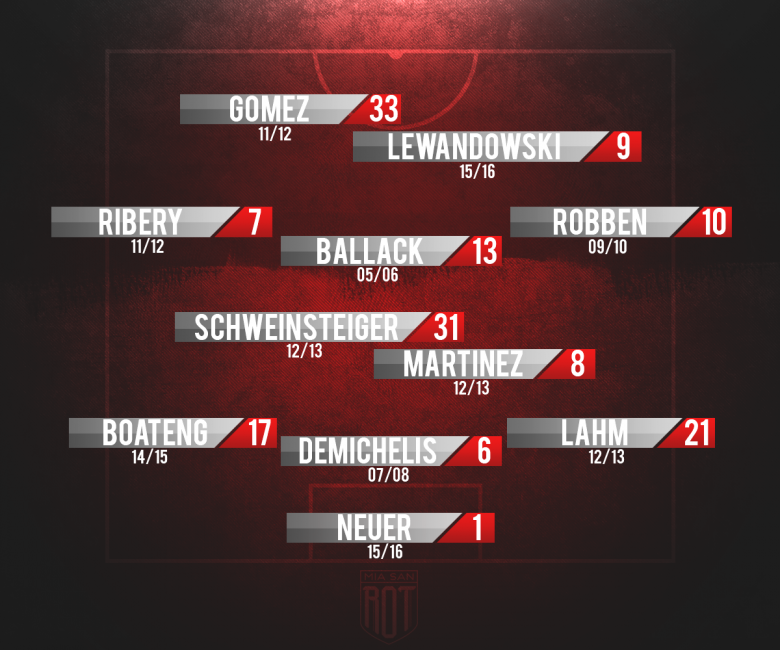
(Visual: Michael Böck)
Goalkeeper: Manuel Neuer, 2015/16
Backup: Oliver Kahn, 2000/01
This choice turned out to be the hardest one, as the author didn’t just have to pick between the arguably two best goalkeepers in German football history, but also between the individual seasons of each great player. In 2007/08, Kahn set the then-record for fewest goals conceded in a single Bundesliga season at 21. A record which Neuer has trumped three times, most recently in 2015/16. In 2002/03, Kahn held Bundesliga opponents without a goal for 17 matches, while Neuer kept clean sheets for 20 and 21 matches in the 2014/15 and 2015/16 seasons respectively. During the 2002/03 campaign, Kahn recorded his best grade average as rated by Kicker at 2.66, which is better than any grade throughout Neuer’s stay at Bayern so far.
In the end, Neuer’s most recent season should turn out to be his best one. Throughout all competitions, he conceded only 29 goals and kept 21 clean sheets, which meant new Bundesliga records in both categories. While his best single-game performances might not have come during this season (even though he had this great save against Arsenal) and his trips outside of the box became scarcer, he didn’t have any bigger flaws as seen in previous seasons (example one and example two from the treble season). Bayern also won two titles that season, with Neuer saving one penalty in the DFP Pokal final against arch nemesis Borussia Dortmund. Neuer gets the small edge over Kahn because his playing style is more complete and perfectly fits the tactics of the post Hitzfeld era with high ball control and passing numbers.
This season will be backed up by Kahn’s 2000/01 campaign. While his season in the league wasn’t the best (conceding 37 goals), he kept nine clean sheets in the Champions League, including the quarter- and semi-final matches in Manchester and Madrid. He also famously saved three penalties in the shootout of the Champions League final that season against Valencia, which led to the greatest achievement of his career, won another Bundesliga trophy in the probably tightest title race ever, and scored a goal in the league match against Hansa Rostock – or at least tried very hard to do so.
Right-back: Phillip Lahm, 2012/13
The inclusion of Lahm in this list was never up for debate, the only question was which season was his greatest. Since at least 2008, Lahm has been considered one of the best players at his position, which changed several times; most prominently when he was moved from left wing to right wing by Louis van Gaal in 2009/10. That season, for the first time, Lahm had ten assists across all competitions. While Lahm is not the fastest wing-back or best crosser, he pairs high football intelligence and great positioning with superb passing. This all came together for him during the treble season in 2012/13. He dished out a career-high 11 league assists and added eight more in the DFB Pokal and the Champions League games. His numbers for interceptions (1.7), clearances (1.2), and key passes (1.8) rank in his personal top 3 since the tracking of advanced stats.
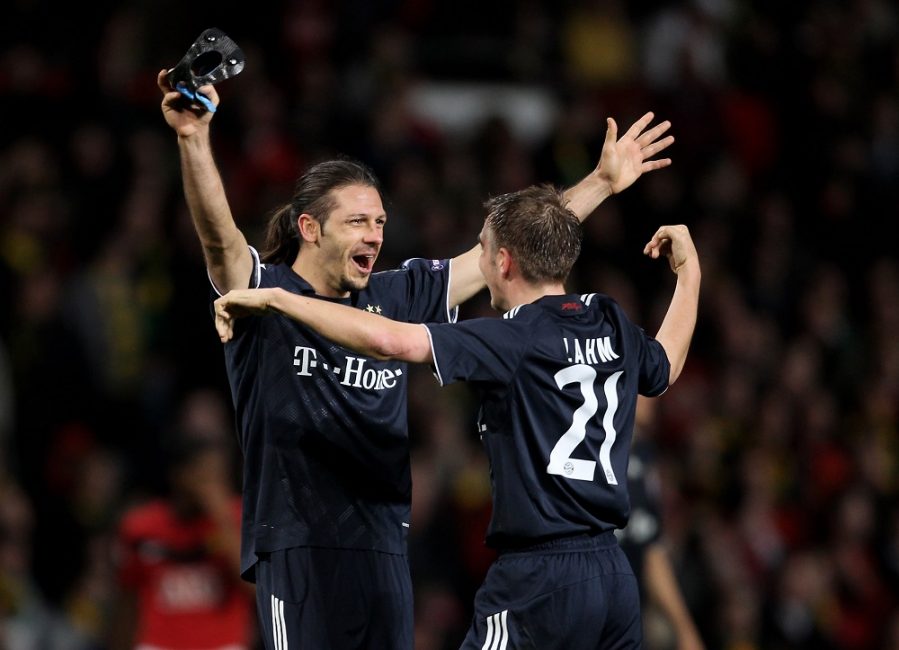
(Photo: Alex Livesey/Getty Images)
Centre-back: Martin Demichelis, 2007/08
Backup: Lucio, 2004/05
Since the 2000s, many high-level defenders have proudly worn the red and white jersey of Bayern. “Micho”, as Demichelis was called by Bayern supporters throughout his stay, was one of them. After a few rough years at the beginning of his stay, he became a starter in the 2005/06 season as a defensive midfielder. In 2007/08, coach Ottmar Hitzfeld decided to put him next to Lucio in central defence more often, the position that Demichelis played in Argentina’s national team. In his favourite position he displayed his full potential as his fearless tackling and good positioning established him as the mainstay in Bayern’s back four. That season, he led Bayern’s defence to a then-record of only 21 conceded goals. German newspaper Kicker graded his season a 2.75, which is tied for second-best among Bayern defenders since the turn of the century, only trailing Boateng’s 2.74 in 2015/16. The Argentinian had 24 tackles per game that season, winning 65% of them. Both are great numbers; to compare, Mats Hummels in 2016/17 is at just 12.8 tackles per game with a league-leading 69 % success ratio.
Demichelis gets the slight edge over Lucio, who put in world-class performances on a regular basis. The Brazilian was the last vertebra that Bayern took from the backbone of Leverkusen’s infamous 2001/02 “Vizekusen”-team. From the day he arrived, he became the undisputed leader of the back four, frightening opposing teams and coach Hitzfeld alike with his trips into enemy territory. His best season according to Kicker was in 2004/05, when he had a 2.86 rating, his best grade average at Bayern. While Lucio managed to stay atop his game several years longer than the Argentinian, his best season cannot match the outstanding 07/08 campaign by Demichelis.
Left-back: Jérôme Boateng, 2014/15
When Bayern signed Boateng from Manchester City ahead of the 2012 campaign as a stabiliser for the defence, they puzzled both supporters and media; the German national team defender was known, first and foremost, for his risky tackles. However, Boateng improved in nearly every aspect of the game during his stay in Munich to become one of the best and most complete defenders in the world – against all odds. He is defined by superb positioning, sheer athleticism, dazzling speed, and much-improved timing of tackles as well as his gorgeous long balls and accurate short passes. All of this is summed up in this video.
Boateng’s peak season as an all-round defender was the 2014/15 campaign right after the World Cup in Brazil when he made a big entrance to the worldwide audience. He has had better years in most categories, going by statistics alone, as his best season in interceptions was 2012/13, his best season in clearances was 2013/14, and his best year for long balls was 2015/16. But in all these categories, his 2014/15 campaign ranks within the top 3. He also had the most key passes per game at 0.8, which is outstanding for a central defender, played a career-high of 87.1 passes per game and had a career-best of 2 tackles per game. Both whoscored.com and Kicker gave him a career-best rating for seasons with at least 20 games played. He also piled up six scorer points in eleven Champions League matches, for example scoring this stunner against his former team Manchester City to assure a last-minute Bayern victory. His worst moment of the season came on the biggest possible stage at a Champions League semi-final in Barcelona, when Boateng fell while being dribbled past by world-class striker Lionel Messi. This led to several vines that went viral on the internet with Boateng as the leading actor.
Defensive Midfield: Bastian Schweinsteiger, 2012/13
The first spot in central midfield is filled by another club legend and another player who excelled in two positions, starting out as a left midfielder and becoming world-class as a defensive midfielder. Schweinsteiger might just be the only link between the Hitzfeld and Magath years with domestically successful Bayern teams, and the dominant years under van Gaal, Heynckes, and Guardiola during which Bayern stepped up into the first European tier. Schweinsteiger, at his peak, combined Mark van Bommel’s defensive craftsmanship of tackling and intercepting passes with the offensive-minded playstyle of an early Michael Ballack. His advances into the opponent’s box were widely feared.
His best overall season was also the most successful in club history – the treble season. In 2012/13, he had career-bests in tackles, interceptions, and through balls. In all other stat categories he ranked within the top 3 of his career, at least since 2009/10. Kicker and whoscored.com gave him the best ratings of his career, and he scored nine goals and assisted eleven more throughout all competitions. As if we needed any further arguments, his back heel goal against Frankfurt was also the decider that sealed the league title.
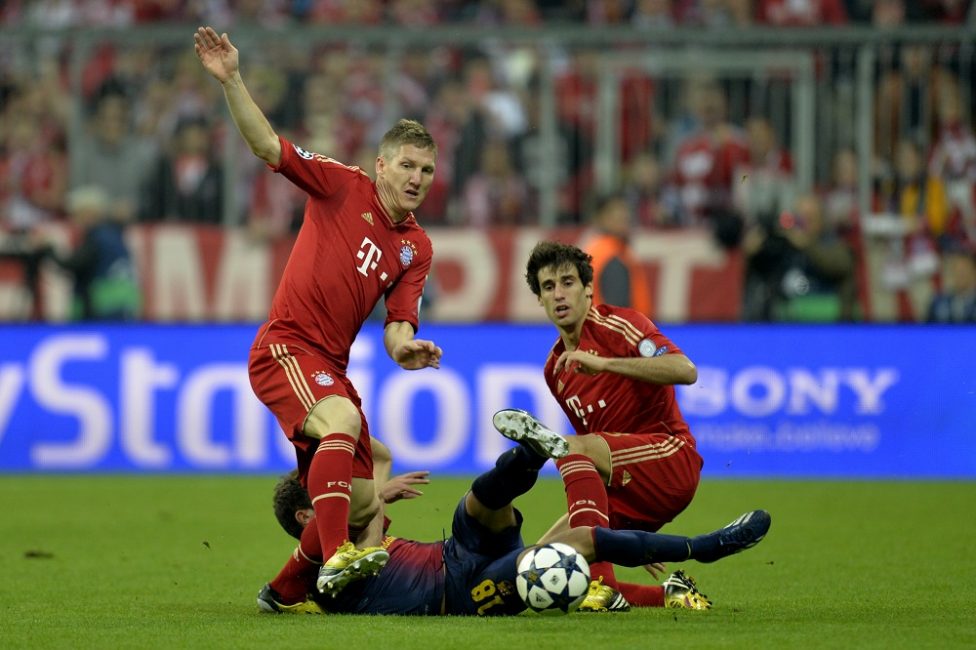
(Photo: ODD ANDERSEN/AFP/Getty Images)
Defensive Midfield: Javi Martínez, 2012/13
After the devastating season ending in 2012, Bayern officials figured they were one defensive player shy of international greatness – so during the summer transfer period, they went ahead and filled that gap. They signed the little known defensive midfielder and centre-back Javi Martínez from Atletico Bilbao for a Bundesliga-record 40 million Euros. The Basque played in 27 league and 11 Champions League matches and proved worthy of his price tag. On the big stage in particular, he delivered superb performances and, together with Schweinsteiger, formed one of the best defensive midfields of the world. While the aforementioned took over the playmaking, Martínez was the defensive anchor. In the Champions League, he averaged 3.8 interceptions per game, which was best for a defensive midfielder with at least eight games. He also had a career-best 3.1 tackles in international matches. His two best games were the semi-finals against Barcelona, where his aggressive playing style led to won tackles and growing frustration among Barca’s superstars, as evident in this video.
Martínez gets the edge over other great Bayern players, most notably Toni Kroos in the treble season, Zé Roberto in 2007/08, and Stefan Effenberg in 2000/01. However, none of these players had the same enormous impact as Martínez, who managed to elevate an already very good Bayern team to the next level.
Right Winger: Arjen Robben, 2009/10
His name is no surprise on this list, but the Dutchman has put in so many incredible seasons that picking out a single one was tough. In his eight seasons at Bayern, Robben has appeared in 214 league and Champions League matches and managed to score 106 and assist another 53 goals. Whoscored rated three of his league seasons at 8.18 points or more. To put that into perspective, last season, the best Bundesliga player (Henrik Mkhitaryan, BVB) was rated at 7.90 points. Just look at the unbelievable ratio of goals and assist per game he has put up.
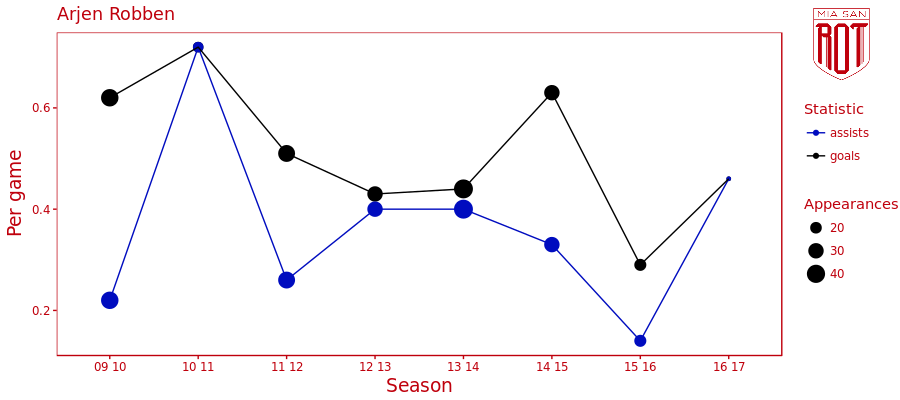
There has been just one season where he didn’t score at least in every third game (!) on average. Three seasons stick out in this graph: his first season at Bayern, when he scored a total of 23 goals throughout all competitions (a career-best), the following season with a career-high of 0.72 goals and assists per game (although those number are not as meaningful as he played just 18 games), and the 2014/15 season, which has career bests for him in both dribbles and shots per game. That last season is also his best by Whoscored and Kicker ratings.
I still chose his first season in 2009/10, because in that year, Robben scored several important goals that carried Bayern to next stage in cup matches: his signature move goal vs Fiorentina making it 2-3, which ultimately sent them to the quarter-finals, his goal of the year at Old Trafford, making it 2-3 again and once more sending Bayern to the next round (this video gives me goosebumps every time I watch it) and of course Robben scoring the game-winner in overtime against Schalke in the DFB Pokal semi-final.
Central Attacking Midfield: Michael Ballack, 2005/06
Backup: Thomas Müller, 2015/16
Similar to the way Ribery and Robben have been irreplaceable in Bayern’s squads since 2007 and 2010 respectively, Michael Ballack was the motor and brain of Bayern in the Magath era of the mid-2000s. In the two double seasons 2004/05 and 2005/06, he scored a total of 27 goals in 53 matches and dished out 10 assists. At his peak, Ballack was an offensive threat with all the necessary tools at his disposal: he had a decent shot from distance, was dangerous when he overloaded the box, and had a superb header. Both of the aforementioned seasons had him at almost the same grade from Kicker, ranking him among the top 5 players in the Bundesliga in both campaigns.
In order to establish which season was better, I looked at a long-forgotten stat called EFFIFU by the sport media group. This index rates the importance of each player’s goals. For example, a game-winning 1-0 is worth more points than the fifth goal of a blowout. The index is available for seasons 2000-2013, and Ballack actually has two seasons where he’s leading the Bundesliga. The 2005/06 season was his career-best with 19.33 EFFIFU points with just 14 goals. His EFFIFU/goal of 1.38 is best throughout the time covered by the index. This further outlines the importance of Ballack and his goals for the successful season of Bayern winning – for the first time ever – a back-to-back double.
The other player who has to be mentioned is Thomas Müller. The home-grown Bayern talent made his debut in 2008 under Jürgen Klinsmann and developed into a starting role under van Gaal in 2009/10, when the latter one famously announced that “Müller always plays”. Since then, Müller has scored 92 league goals, making him fifth on Bayern’s internal all-time high scoring list. Müller also has had four season with more than 10 assists. However, the 2015/16 campaign will be featured as a backup to Ballack as Müller had career-highs in both goals (20) and shots per game (3). His interaction with Lewandowski led both players to new personal bests. The team could also rely on Müller in big moments, for example when he scored the much-needed equalizer against Juventus Turin in the final seconds of the quarter-final to send the game into overtime. Ballack still gets the edge, because he had to carry the team all by himself while Müller can rely on other players around him.
Left Winger: Franck Ribéry, 2011/12
The situation for the Frenchman is similar to Robben’s: his inclusion in this team was never at debate, however, choosing his best year is quite difficult as he has put in one stellar season after another. In a total 362 games for Bayern he has scored 103 goals and assisted another 162. Unlike Robben, his numbers for assists per game have always been higher than his goals per game. He has also never managed to score more often than 0.4 goals/game (which is still great for a left winger – don’t get me wrong). The statistics clearly show that Ribéry, much more so than the Dutchman, made his teammates better by getting them into good scoring positions.
His best overall season was the dramatic 2011/12 campaign which ended with second places in all competitions; the most balanced year of his career. He had better scoring seasons and he had seasons with more assists on a per-game basis, but he managed to stay healthy as he logged 48 games and had career-bests in total goals and assists. Furthermore, his performances were similarly good on both national and international level, unlike 2012/13, when Whoscored rated his Champions League season at the second-lowest point of his career (quite ironic as the UEFA awarded him the European player of the year award that season). His numbers in key passes, shots and dribbles were not career-bests, but consistent at a high level and mostly above his career averages.
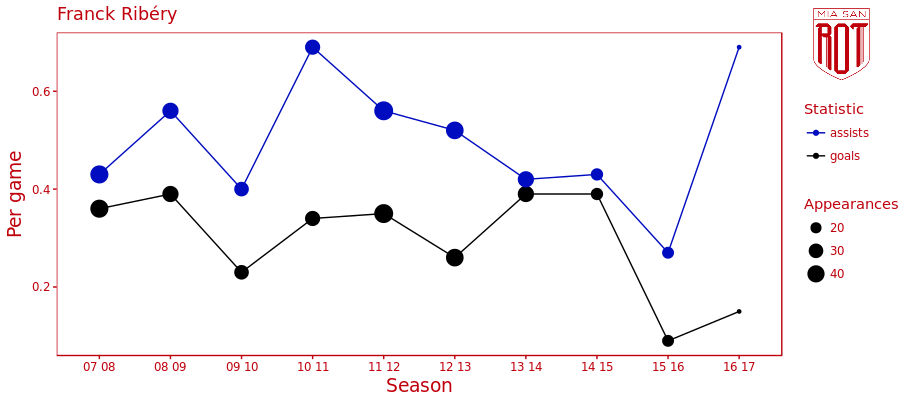
Striker: Mario Gomez, 2011/12
Elber, Pizarro, Makaay, Klose, Toni, Gomez, Mandžukić, Lewandowski – the names of the Bayern strikers since the 2000s may not have been all-European first-tier names like Ronaldo, Messi, van Nistelrooy or Eto’o, but every single one of these forwards had their share of superb outings and scored many crucial goals in all competitions. This makes the task of choosing two single seasons all the more challenging.
In order to establish a fair comparison, the following graph was made. It shows the share of league goals each striker scored for his team, considering his playing time.
For example, Pizarro scored 10 league goals in 682 minutes in 2014, while Bayern’s total number was 94 league goals in 3,060 minutes. Broken down to his share of playing time – assuming an even distribution of goals for all the 3,060 minutes, which of course is not entirely accurate – Pizarro accounted for 47.7% of his team’s goals during his time on the pitch. This share of team league goals is displayed over the total amount of goals scored by that player over the course of the season in all competitions. The seasons by Gomez (green), Toni (red) and Lewandowski (yellow) are highlighted in the respective colour, while blue dots represent the seasons of the other Bayern forwards.
If you look at the graph, four seasons are separated from the rest: Three players managed a total of four seasons where they accounted for at least 40 % of their team’s league goals and scored a total of 35-plus goals in all competitions: Toni in 2007/08 had his share of 40.9% and scored 39 goals total, Gomez, who did it twice, in 2010/11 for 43.3% and 39 total and in 2011/12 for 41.7% and 40 goals, and recently Lewandowski in 2015/16 for 43.3% and 42 goals.
Out of these four marvellous seasons, only two can get a spot in this “Magnificent Eleven”. The first selection is Mario Gomez, just because he is the only Bayern striker since the 2000s to have two extremely outstanding seasons. His 2011/12 season, however, will get the slight advantage over the previous season for the following reasons. Not only did he score one more goal in 2011/12, but his EFFIFU (see Ballack for details) is way higher at 24.0 compared to 18.2 the previous year. This states that his goals in the 2011/12 season were more important, as he more often than not scored a game-winner or secured a late point. His most notable goal that season was against Real Madrid in the first leg of the Champions League semi-final when his goal in stoppage time made it 2-1 for the Bavarian side, a result which ultimately was enough for Bayern to beat Real on penalties at Bernabéu. In the end, Gomez had career-bests in Champions League goals (12), shots per game (3.1), and league assists (4) that season. If you speak German, you might enjoy this piece from Miasanrot where they evaluated the greatness of Mario Gomez as the “best since Gerd Müller”.
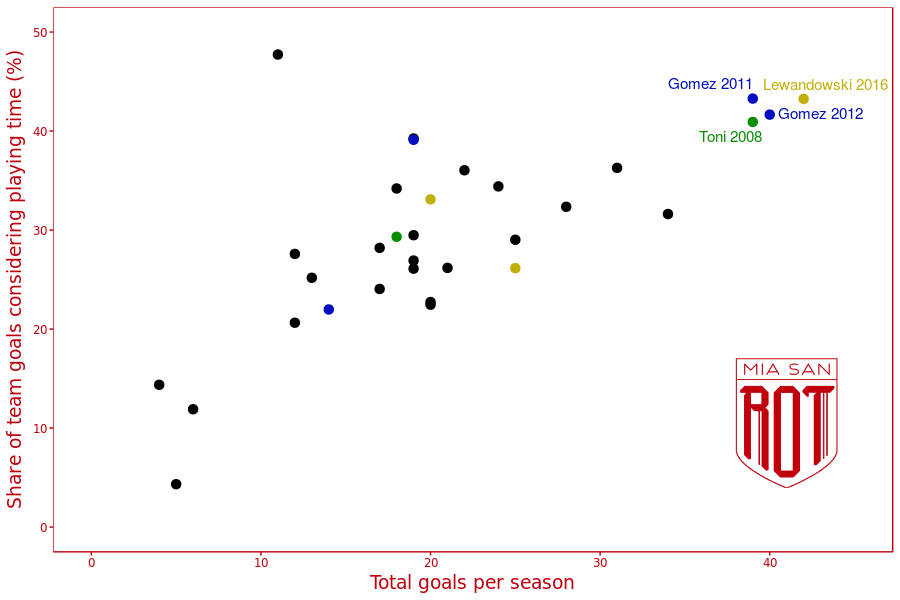
Striker: Robert Lewandowski 2015/16
Backup: Luca Toni, 2007/08
For the final slot, this leaves us with Lewandowski versus Toni in their respective best season. Considering that Lewandowski scored three more goals and his share of team goals was 2.4% higher, as well as remembering that ten of Toni’s 39 goals were scored in the inferior Euro League, or UEFA Cup as it was called back then, the choice seems clear. The Polish striker became the first Bundesliga forward to score more than 30 goals in a single season since Dieter Müller in 1976/77. He also added nine goals in the Champions League, including two crucial goals against Juventus and Atlético.
His masterpiece, however, happened on a September night in 2015 when he scored five (!!!!!) goals in nine (!!!!!!!!!) minutes against rival Wolfsburg after being subbed on at halftime. In this phenomenal performance that calls for yet-to-be-invented superlatives, he broke several Bundesliga and worldwide records, including fastest hat trick and most goals scored as a sub. On the German version of Miasanrot you can go back to that faithful night in Munich and read the original commentary as given by Sky commentators Wolff Fuss and Lothar Matthäus.
Furthermore, Lewandowski fired a league-leading and career-best 4.8 shots per game at opposing goalkeepers, as well as an astonishing and also career-best 3.4 shots from inside the box. His rather low numbers (at least in comparison to his previous seasons) in key passes and dribblings indicate that he turned much more into an ice-cold striker who was put in good scoring position by his teammates. However, his number of passes per game were the highest since he joined Bayern.
This concludes the selection of the “Magnificent Eleven” of single seasons by Bayern players since the 2000s. Some of these choices were pretty obvious, others are more debatable. I tried my best to support my selections by statistics taken from transfermarkt.de, whoscored.com, effifu.de, and kicker.de. However, especially for the early seasons, the amount of statistics is insufficient, which is one of the reasons why I had to rely on the subjective eye-test and the controversial grading by Kicker.








As much as i would like to say Jerome Boateng deserves to be in the lineup Lizarazu was the bomb on the left defensively solid and extremely competent going forward. Wonderful read, loved the detail put into each choice.
Keep up the good work